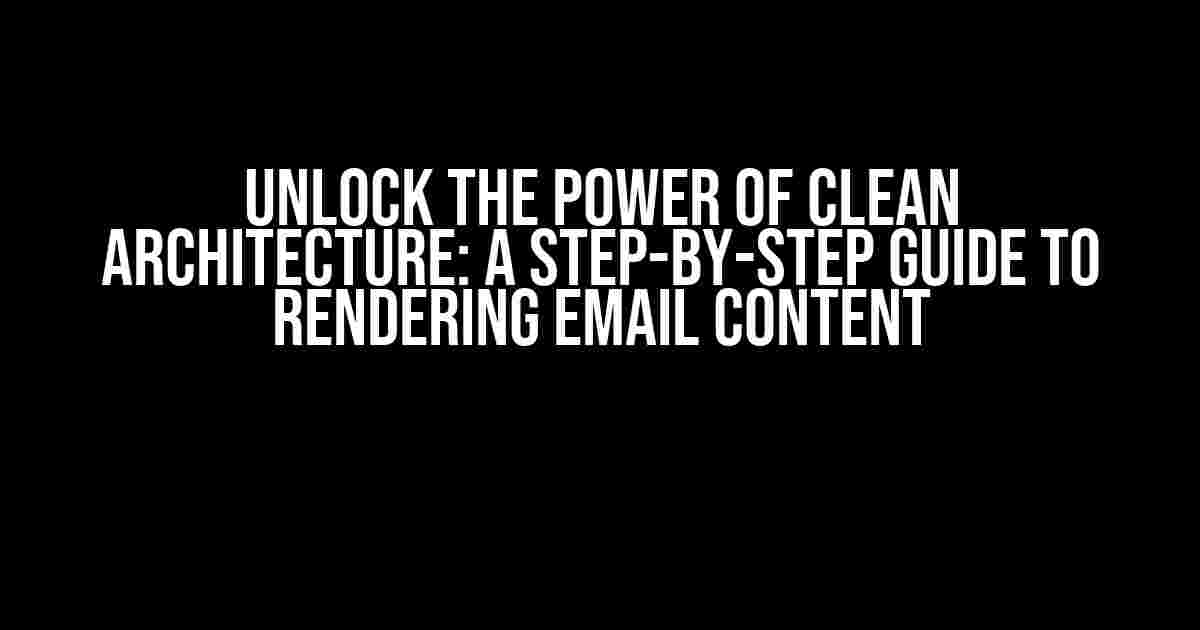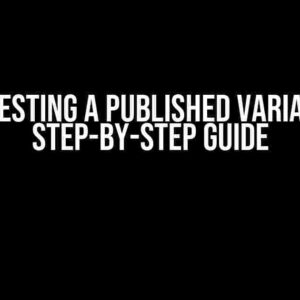Are you tired of tangled, unmaintainable codebases that make it a nightmare to render email content? Do you dream of a world where your architecture is clean, scalable, and efficient? Look no further! In this comprehensive guide, we’ll dive into the world of clean architecture and explore how to render email content with ease.
What is Clean Architecture?
Clean architecture is a software design pattern that seeks to separate the application’s business logic from its infrastructure and presentation layers. The goal is to create a decoupled, modular system that’s easy to maintain, test, and extend. In the context of rendering email content, clean architecture helps us to isolate the email rendering process from the rest of the application, making it more efficient and flexible.
The Benefits of Clean Architecture
- Improved maintainability: With clean architecture, you can modify or replace individual components without affecting the entire system.
- Enhanced scalability: Clean architecture makes it easier to add new features or modules as your application grows.
- Faster development: By separating concerns, you can work on different parts of the application simultaneously, reducing development time.
- Better testability: Clean architecture enables you to write unit tests and integration tests more easily, ensuring your application is robust and reliable.
Understanding the Layers of Clean Architecture
A clean architecture typically consists of four layers:
| Layer | Description |
|---|---|
| Entities | Represent the business domain, including data models and business logic. |
| Use Cases | Define the actions that can be performed on the entities, such as creating, reading, updating, and deleting. |
| Interface Adapters | Act as a bridge between the use cases and the infrastructure, providing a way to interact with the outside world. |
| Infrastructure | Includes the frameworks, databases, and other external dependencies that support the application. |
Rendering Email Content with Clean Architecture
Now that we’ve covered the basics of clean architecture, let’s dive into the specifics of rendering email content. We’ll explore a step-by-step guide to implementing a clean architecture for email rendering.
Step 1: Define the Entities
In this layer, we’ll define the entities that represent the email content. For example:
public class EmailContent {
private string subject;
private string body;
private List<string> recipients;
// Getters and setters
}
Step 2: Define the Use Cases
In this layer, we’ll define the actions that can be performed on the email content entities. For example:
public interface RenderEmailUseCase {
void renderEmail(EmailContent emailContent);
}
Step 3: Implement the Interface Adapters
In this layer, we’ll create an interface adapter that will interact with the infrastructure to render the email content. For example:
public class EmailRendererAdapter implements RenderEmailUseCase {
private EmailService emailService;
public EmailRendererAdapter(EmailService emailService) {
this.emailService = emailService;
}
@Override
public void renderEmail(EmailContent emailContent) {
emailService.sendEmail(emailContent.getSubject(), emailContent.getBody(), emailContent.getRecipients());
}
}
Step 4: Implement the Infrastructure
In this layer, we’ll implement the infrastructure that will be used to render the email content. For example:
public class EmailService {
private SMTPClient smtpClient;
public EmailService(SMTPClient smtpClient) {
this.smtpClient = smtpClient;
}
public void sendEmail(string subject, string body, List<string> recipients) {
// Use the SMTP client to send the email
}
}
Benefits of Using Clean Architecture for Email Rendering
By using clean architecture to render email content, you can enjoy the following benefits:
- Decoupling: The email rendering process is decoupled from the rest of the application, making it easier to maintain and update.
- Flexibility: You can swap out different email services or rendering engines without affecting the rest of the application.
- Scalability: Clean architecture makes it easier to add new features or modules as your application grows.
- Testability: You can write unit tests and integration tests more easily, ensuring your email rendering process is robust and reliable.
Conclusion
In this article, we’ve explored the world of clean architecture and how it can be used to render email content with ease. By following the steps outlined in this guide, you can create a decoupled, modular system that’s easy to maintain, test, and extend. Remember, clean architecture is not just a design pattern – it’s a way of thinking that can revolutionize the way you approach software development.
So, what are you waiting for? Start implementing clean architecture in your next project and experience the benefits of decoupling, flexibility, scalability, and testability. Your codebase (and your colleagues) will thank you!
Happy coding!
Frequently Asked Question
Get answers to your burning questions about clean architecture and rendering email content!
What is clean architecture, and how does it relate to rendering email content?
Clean architecture is an architectural pattern that separates the application logic into layers, making it easier to maintain and scale. In the context of rendering email content, clean architecture helps to decouple the email rendering logic from the business logic, allowing for a more modular and flexible approach to building email templates and content.
How does clean architecture benefit email rendering performance?
By separating the email rendering logic into its own layer, clean architecture allows for optimizations to be made specifically for email rendering, without affecting the rest of the application. This can lead to significant performance improvements, as the email rendering process can be tailored to the specific needs of the email content.
What are some common challenges when implementing clean architecture for email rendering?
Some common challenges include dealing with complex email template logic, handling large volumes of email data, and integrating with existing email services or infrastructure. Additionally, ensuring that the clean architecture implementation meets the specific needs of the email rendering use case can also be a challenge.
Can clean architecture be used for other types of content rendering, beyond email?
Yes, clean architecture is not limited to email rendering and can be applied to other types of content rendering, such as web page rendering, document rendering, or even IoT device rendering. The core principles of clean architecture can be applied to any use case that requires a decoupling of business logic from presentation logic.
How does clean architecture impact the development process for email rendering?
Clean architecture can impact the development process by requiring a more deliberate and structured approach to building email rendering functionality. This can lead to a more maintainable and scalable codebase, but may also require additional upfront planning and design effort.



